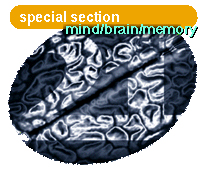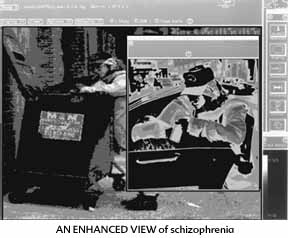

Drug mechanisms and brain function: the antipsychotic experience
By JACK M. GORMAN
RECENT DEVELOPMENTS IN schizophrenia research have shed considerable light on the putative mechanism of action of antipsychotic medications. These investigations have also produced unexpected insights into the function of the normal brain and even the vagaries of personality.
 Drugs
capable of ameliorating the most florid symptoms of schizophrenia were introduced into the
United States in the late 1950s. Beginning with chlorpromazine (better known by its brand
name, Thorazine), these drugs directly treat hallucinations, delusions, thought disorder, and
behavioral disturbance characteristic of psychotic illnesses. Between the late 1950s and early
1970s a number of drugs with similar action, called antipsychotics or neuroleptics, were
introduced, including haloperidol (Haldol), trifluoperazine (Stelazine), thioridazine (Mellaril),
and fluphenazine (Prolixin). Their side effects vary, but all these agents have the same
benefits and liabilities: Each can decrease the most acute symptoms of schizophrenia and
other psychotic illnesses, like bipolar mania and delusional depression, but also can produce
profound adverse neurologic reactions.
Drugs
capable of ameliorating the most florid symptoms of schizophrenia were introduced into the
United States in the late 1950s. Beginning with chlorpromazine (better known by its brand
name, Thorazine), these drugs directly treat hallucinations, delusions, thought disorder, and
behavioral disturbance characteristic of psychotic illnesses. Between the late 1950s and early
1970s a number of drugs with similar action, called antipsychotics or neuroleptics, were
introduced, including haloperidol (Haldol), trifluoperazine (Stelazine), thioridazine (Mellaril),
and fluphenazine (Prolixin). Their side effects vary, but all these agents have the same
benefits and liabilities: Each can decrease the most acute symptoms of schizophrenia and
other psychotic illnesses, like bipolar mania and delusional depression, but also can produce
profound adverse neurologic reactions.
Physicians quickly realized that all these agents shared a specific action in the central nervous system: blockade of the type 2 receptor for the neurotransmitter dopamine (D2). D2 blockade is clearly the reason the traditional antipsychotics cause side effects, but is it also the mechanism behind antipsychotic action? Because the drugs' clinical potency seemed to correlate almost perfectly with their affinity for the D2 receptor, scientists leaped to the conclusion that excessive amounts of dopamine in the brain must be the cause of schizophrenia. Thus began a nearly 30-year adventure in which clinical investigators attempted to prove this dopamine hypothesis.
Signals that the theory could not be correct were noted early on but frequently avoided. Even though there was ample evidence that the dopamine hypothesis cannot explain everything about schizophrenia, the available technology to explore the human brain limited scientists' ability to move beyond this theory. Rather than give up, many simply held on to it, grasping at every straw of evidence consistent with dopamine as the main player in the etiology of schizophrenia. (This illustrates for neuroscience what has been known in other fields for years: Progress depends on technological advances.) Although D2 receptors are almost entirely blocked after only a day or two of antipsychotic administration, responses to these drugs generally take weeks. Furthermore, no convincing evidence could be found that dopamine levels differ between patients with schizophrenia and unaffected individuals.
The major blow to the dopamine hypothesis came five years ago with the introduction of clozapine, the first new antipsychotic drug on the U.S. market in almost 20 years. Clozapine proved more effective than the traditional antipsychotics; approximately 30 percent of patients with schizophrenia that is entirely refractory to the older drugs respond to clozapine. Clozapine also treats a wider range of symptoms than the traditional drugs and does so without producing any of the adverse neurologic side effects. Although a blood abnormality called agranulocytosis occurs in approximately 1 percent of patients, requires weekly blood testing, and therefore limits its use, clozapine has revolutionized the treatment of schizophrenia.
Clozapine also radically altered our thinking about the mechanism of action of antipsychotics. It is a relatively weak D2 receptor blocker and has potent activity at a receptor for a completely different neurotransmitter, serotonin (also known as 5-HT). A high ratio of 5-HT to D2 receptor-blocking activity now defines a new class of drugs called atypical antipsychotics. Risperidone was the second to be introduced, and at least four others--olanzapine, sertindole, seroquil, and ziprasidone--are nearing approval. The theory that serotonin is also involved in the pathogenesis of schizophrenia is now under active investigation.
A hypothesis revived and refined
THREE RECENT FINDINGS from disparate sources, however, give the dopamine hypothesis new life. To date, five subtypes of dopamine receptor, each with interesting properties and specific distributions in the brain, have been identified and cloned. Affinities vary among the antipsychotics for different subtypes; clozapine, for example, has relatively high activity at the D4 receptor, which is strategically located in many of the exact brain regions scientists now think may function abnormally in schizophrenia. Columbia scientists are actively working to characterize the structure and molecular properties of the subtypes of dopamine receptor and to prepare radioactively labeled markers that will allow precise brain imaging studies in patients with schizophrenia.
It is also increasingly clear that these drugs probably do not act simply by binding to receptors and blocking the ability of neurotransmitters to attach to them. The binding of a drug to its receptor is surely only the first step of a cascade of events that occur inside a neuron, ultimately leading to an antipsychotic effect. Scientists are now unraveling the complexities of intraneuronal signaling among a host of "second" messengers that ultimately influence the cell's DNA.
 Scientists
also have recently succeeded in knocking out the gene that codes for a protein critical to
dopamine transport into a neuron in a mouse model. The dopamine transporter knockout
mouse becomes behaviorally hyperactive, resembling an animal given cocaine or
amphetamine. Because both these substances can produce psychotic states in humans, these
findings suggest that disruption of normal dopamine transmission may indeed have a role in
schizophrenia and like illnesses.
Scientists
also have recently succeeded in knocking out the gene that codes for a protein critical to
dopamine transport into a neuron in a mouse model. The dopamine transporter knockout
mouse becomes behaviorally hyperactive, resembling an animal given cocaine or
amphetamine. Because both these substances can produce psychotic states in humans, these
findings suggest that disruption of normal dopamine transmission may indeed have a role in
schizophrenia and like illnesses.
Finally, variations in the human gene coding for the D4 receptor have now been linked with specific differences in personality. One genetic polymorphism is associated with increased risk-taking. This is one of the first demonstrations that genetic predisposition underlies some aspects of human personality, independent of environment or background. Because schizophrenia is also clearly at least in part a genetic illness, scientists have resumed considering the possibility of abnormalities in genes coding for the many proteins involved in dopamine neurotransmission.
It is unlikely that any abnormality in a single brain chemical, including dopamine, will explain all the features of a disorder as complex as schizophrenia. Many other neurotransmitters and networks of neurons are under active investigation. At Columbia and the New York State Psychiatric Institute, several scientists involved with the Developing Clinical Research Center for the Study of Schizophrenia are studying dopamine neurotransmission. Dr. Dolores Malaspina, co-principal investigator of the center, is attempting to image dopamine receptors using sophisticated brain imaging technology; she and her colleagues hope to determine in living patients whether abnormalities exist in the number or function of D4 receptors. Dr. Jonathan Javitch of Columbia's Center for Molecular Recognition is studying the structure of dopamine receptors, attempting to understand exactly what elements differentiate the five known subtypes. Dr. Stephen Rayport has shown that dopamine is often "co-localized" with another neurotransmitter, glutamate, which is now considered important in a variety of human diseases, including stroke and schizophrenia. Finally, a team of genetic researchers at Columbia and the Psychiatric Institute, including Drs. Conrad Gilliam, Charles Kaufmann, Nikki Erlenmeyer-Kimling, and Malaspina, is investigating whether genes coding for dopamine transmission proteins are abnormal among patients with schizophrenia.
The dopamine story highlights an important trend in modern psychiatric research. Clinical scientists studying the phenomenology and pharmacology of an illness are increasingly joined by molecular biologists and geneticists to cover a great deal of ground in understanding a disease process. In this case, the convergence of effort has led to far better treatment of schizophrenia and new understanding of normal brain function and human personality.
PHOTO & ART CREDITS: Jonathan Smith (1); Jonathan Smith/Special effects by Howard
Roberts (2)
JACK M. GORMAN, M.D., is
professor of clinical psychiatry and deputy director of the New York State Psychiatric
Institute.




